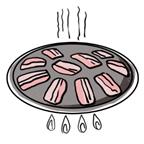In this lesson we’ll learn how to make simple sentences using what we’ve learned so far. We’ll also learn about basic sentence structure in Korean. Let’s go over the conversation, and then break it down a bit to understand it. Try reading each part on your own first.
Conversation

철수: 저는 고양이를 좋아합니다.
영희: 저는 고양이를 싫어합니다. 개를 좋아합니다.
철수: 저는 김치를 좋아합니다.
영희: 저는 삼겹살을 더 좋아합니다.
Let’s take a look at each sentence in the conversation one at a time.
철수: 저는 고양이를 좋아합니다.
"I like cats."
Korean Sentence Structure
English is an "SVO" language. "SVO" means that the language uses sentences structured with a subject, followed by a verb, and then an object. Let’s take the sentence "I eat food." "I" is the subject, "eat" is the verb, and "food" is the object that is being eaten.
Korean is an "SOV" language. This means that the object will always come before the verb, so the sentence "I eat food" would be structured "I food eat" in Korean – the subject, followed by the object, and then the verb. Become comfortable with this structure as soon as you’re able to, as it’s what all of Korean grammar is based upon. It’s quite important!
We learned previously that 저 is used to say "I" or "me," and that 는 (the Topic Marker) is added onto the end to mark that we’re talking about "me." 고양이 means cat, and it’s followed by the Object Marker, here 를.
영희: 저는 고양이를 싫어합니다. 개를 좋아합니다.
"I dislike cats. I like dogs."
Notice that the second sentence, "I like dogs," doesn’t begin with 저는 like the first one does. This is because we already said that we’re going to be talking about "me" in the first sentence, so there’s no need to repeat 저는 in the second sentence, assuming we’re still referring to "me."
Remember that anytime it’s clear what the topic is, feel free to omit it.
철수: 저는 김치를 좋아합니다.
"I like kimchi."
What is 김치?

A long time ago before there were refrigerators, people had to get creative to find ways to make their food last longer. Often, adding some type of preservative (salt) to food allowed it to stay edible for a long time. Koreans began adding salt to cabbage, then storing it underground where it was cooler in large clay pots. It would ferment (get old with the help of bacteria), but remain safe to eat. This allowed people to eat cabbage all year round, which was a good source of vitamins and fiber. More recently, Koreans added red peppers to the recipe, and led us to what 김치 is today – spicy, fermented (and delicious) cabbage.
There are more varieties of 김치 than could ever fit in this book. I encourage you to experiment and try some if you’re able to get your hands on any. There’s a saying that language learners who love to eat 김치 speak the best Korean.
영희: 저는 삼겹살을 더 좋아합니다.
"I like pork belly more."
What is 삼겹살?

삼겹살 is sliced pork belly, which resembles thick bacon, but has not been cured or salted. It’s fried directly at tables in restaurants, cut into bite-sized pieces, and eaten with a combination of vegetables, side dishes, and 김치. I’m not going to talk about 삼겹살 anymore because it’s making me hungry.
Adverbs in Korean
In Korean, adverbs are most often placed directly before a verb.
저는 티파니를 사랑합니다.
"I love Tiffany."
저는 제시카를 더 사랑합니다.
"I love Jessica more."
더 is an adverb which means "more." Its opposite is 덜, which means "less."
저는 수지를 덜 좋아합니다.
"I like Suzy less."
Advanced Notes:
Although using adverbs after a verb can sometimes be acceptable in casual conversation, it is not the norm. For better-sounding and clearer Korean, only use adverbs directly before verbs.
Plurals
Let’s take one more look at the first sentence in the example conversation.
철수: 저는 고양이를 좋아합니다.
"I like cats."
고양이 means "cat," but notice how the English translation is "I like cats" and not "I like cat."
In Korean, using plurals is optional. It’s only necessary to use a plural when you need to emphasize that something is plural.
고양이 therefore can mean either "cat" or "cats," depending on what fits better in the sentence.
But sometimes you might need to emphasize that something is plural. If you do, here’s how you do it.
Noun + 들
Take any noun you want to make plural, and attach 들.
고양이 "cat"
→ 고양이들 "cats"
원숭이 "monkey"
→ 원숭이들 "monkeys"
However, remember that most of the time, you won’t need to use 들.
저는 원숭이를 좋아합니다.
"I like monkeys."
But you wouldn’t say, 저는 원숭이들을 좋아합니다.
It would be unnecessary, and strange, to add 들 since it is already clear that we mean "monkeys" and not "monkey."
Articles
English uses articles such as "a," "an," and "the" to indicate several things, such as quantity ("a car" can mean "one car"), or to be specific about a certain thing ("the car" refers to a car that the speaker has already previously referred to). There’s good news – Korean has no such thing to worry about.
In the future, we will cover how to indicate quantity simply using numbers (Chapter 13), and how to be specific about a certain thing by pointing out "this" or "that" (Chapter 11).
Practice
Translate to English:
1. 저는 고양이를 더 좋아합니다.
2. 저는 개를 더 좋아합니다.
Translate to Korean:
3. I like movies.
4. I like books more.
5. I dislike bugs.
6. I dislike spiders more.
New Vocabulary
고양이 - "cat"
개 - "dog"
원숭이 - "monkey"
벌레 - "bug," "insect"
거미 - "spider"
책 - "book"
작가 - "author"
사전 - "dictionary"
전자 사전 - "electronic dictionary"
영화 - "movie"
김치 - "kimchi"
삼겹살 - "pork belly"
더 - "more" (adverb)
덜 - "less" (adverb)